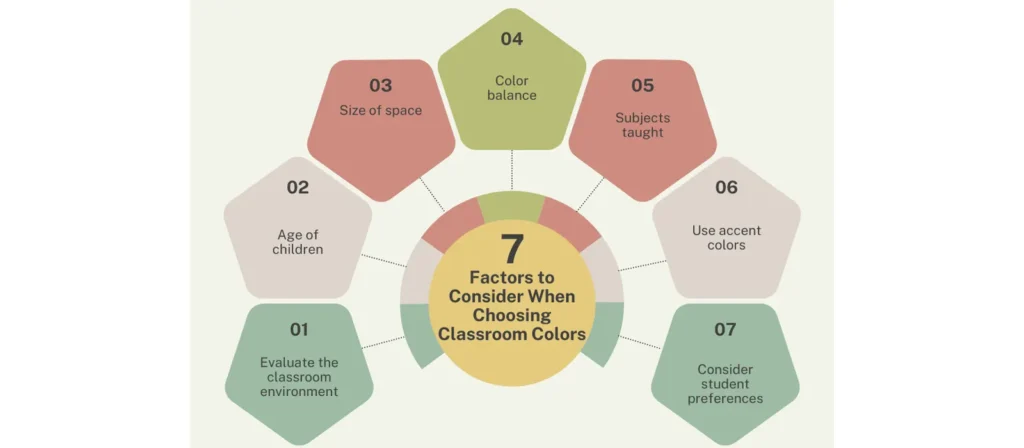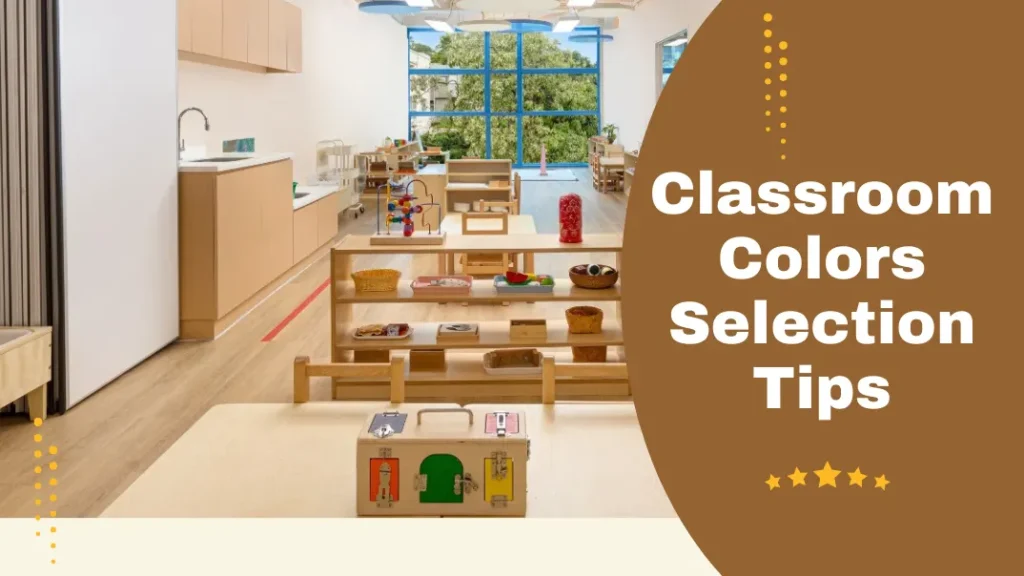Choosing the right classroom colors can be overwhelming. With so many options and factors, it’s easy to feel lost. However, your chosen colors can profoundly impact students’ mood, attention, and learning ability. How can you ensure that your color choices promote a productive, stimulating, and comfortable environment for learning?
Classroom colors are more than just aesthetic choices—they influence students’ emotions, concentration, and overall behavior. By understanding the impact of different colors, teachers can create environments that encourage learning, boost creativity, and foster emotional well-being. Choosing the right colors for your classroom will create a more effective, harmonious learning environment.
We’ll cover the importance of colors, factors to consider when selecting, and the best colors for enhancing learning. Whether designing a new classroom or renovating an existing one, this guide will help you choose the perfect palette.
Importance of Classroom Colors
The colors in a classroom go beyond decoration. Classroom colors can impact student behavior, focus, emotions, and learning outcomes. Research shows that different colors influence concentration, creativity, and overall mood. For instance, blue and green tones are widely recognized as calm classroom colors that promote focus, while warm hues like orange and yellow bring energy and creativity.

A colorful classroom that is visually engaging yet not overstimulating can improve how students feel and perform. If a classroom’s color scheme makes students feel relaxed and engaged, they are more likely to focus on tasks and interact positively. On the other hand, using overly dark or intense colors can increase stress levels and reduce productivity.
You can create spaces that foster learning, growth, and emotional well-being with the right classroom color themes. Incorporating colorful classroom decorations makes the room welcoming and adds warmth, helping students feel comfortable and engaged.
Factors to Consider When Choosing Classroom Colors
Selecting the best classroom color schemes requires more than choosing shades from a color chart. It’s essential to think about the classroom’s environment, intended use, and the unique needs of students. Here are key factors to consider:

1. Evaluate the Classroom Environment
Consider the physical environment when choosing classroom colors. Does the room get a lot of natural light? Is it small or large? Does it already have a specific color palette? The answers to these questions help you choose classroom color schemes that best suit the space. For example, classrooms with limited natural light can benefit from bright color options like soft yellows or whites, making the space more open and welcoming.
2. Age of Children
The age group you teach plays a significant role in color choice. Younger students often benefit from primary color-themed, vibrant, vibrant-colored classrooms that stimulate curiosity and energy. In comparison, older students thrive in calming classroom colors that aid focus, like soft blues and greens. A colorful classroom theme is great for preschool classrooms, where bright, colorful classroom decorations engage and inspire children.
3. Size of Space
The room’s size affects how colors are perceived. Larger classrooms can handle bold colors on walls or colorful classroom decor like large posters or furniture accents. Smaller classrooms benefit from softer, more subtle tones, such as soothing classroom colors in pastels, which help make the space feel less cramped.
Don’t just dream it, design it! Let’s chat about your custom furniture needs!
4. Color Balance
Balance is key when designing classroom color combinations. Too many bright tones can overstimulate students, while too many neutrals can dull the space. A thoughtful balance—using neutral color classroom decor as a base, accented with brighter tones—creates a visually engaging space that doesn’t overwhelm students.
5. Subjects Taught
Some subjects naturally lend themselves to specific classroom colors for learning. For instance, art classrooms may benefit from bold, dynamic colors that inspire creativity. In contrast, math or science classrooms can utilize calm classroom colors like green or blue to encourage focus and logical thinking.
6. Use Accent Colors
Accent colors can help define different spaces within the classroom, such as a reading corner or group work area. Strategic use of bright colors like orange and yellow can highlight certain areas.
7. Consider Student Preferences
Student preferences matter too. Some students may have strong likes or dislikes for specific colors, so considering this when choosing classroom colors can help foster a space where students feel comfortable and engaged.

Classroom Colors That Aid Learning
Different colors can have unique psychological effects, making certain shades better suited for classroom color schemes than others. Here are some colors that are commonly used in colorful classrooms and how they aid learning:
- Orange
Orange is vibrant and energizing, ideal for promoting social interaction and creativity. It’s perfect for spaces where group activities happen. However, use it sparingly, as too much orange can be overwhelming.
- Green
Green is calming and helps with focus. It’s one of the best classroom colors for learning as it reduces stress and is gentle on the eyes, making it a perfect choice for study areas.
- Red
Red grabs attention and increases alertness. While too much red can be agitating, it can be used effectively as an accent color to encourage alertness in active learning spaces.
- Blue
Blue promotes calmness and enhances focus, making it one of the best classroom colors for quiet areas where concentration is key. Its soothing effect makes it ideal for reducing stress.
What Are Some Calming Colors in the Classroom?
Calming colors for classrooms are ideal for areas where students need to relax and focus, such as reading corners or quiet zones. Here are some of the most effective calming classroom colors:

- Soft Blue: Known for its soothing effects, it helps students feel calm and reduces anxiety.
- Lavender: Light purple tones create a tranquil atmosphere and stimulate creativity.
- Light Green: Green has a grounding effect, which is ideal for areas where focus is needed.
- Beige: A warm neutral that provides a peaceful, hidden background.
- Pastels: The pastel colors classroom theme works well to create a light, airy, and soothing environment.
The Impact of Classroom Colors
Here’s how different classroom colors impact students psychologically and which areas of the classroom they’re best suited for:
| Color | Psychological Impact | Best Use |
|---|---|---|
| Blue | Calming, promotes focus and concentration | Long study sessions, reducing stress |
| Green | Balances and soothes, ideal for sustained concentration | Science, reading areas, quiet learning spaces |
| Yellow | Activity zones, sports, or interactive areas | Art or brainstorming areas |
| Red | Clean and neutral, it helps clarity and focus | Energizing boosts motivation |
| Orange | Warm and inviting, encourages social interaction | Group activities, collaborative workspaces |
| White | Inspiring promotes creativity and imagination | General classroom walls, flexible spaces |
| Purple | Inspiring, promotes creativity and imagination | Art or design classrooms |
| Brown | Grounding and comforting, ideal for stability | Library corners, reading nooks |
Classroom Furniture Colors
Classroom furniture colors are key to creating an engaging and comfortable learning environment. Here are some popular choices:
- Neutral Furniture: Neutral color classroom decor and furniture help balance the room, allowing brighter colors on the walls or decorations to stand out. White, beige, or gray tones create a calm, orderly setting.
- Colored Bins for Classroom: Using colored bins for classroom storage adds a fun, practical element to keep students organized. Brightly colored bins are not only practical but also add color without overwhelming the space.
- Brightly Colored Furniture: Bright furniture adds vibrancy, particularly in younger classrooms. Bold chairs or tables can energize students but should be balanced with neutral walls to prevent overstimulation.
- Wooden Furniture: Natural wood tones provide a warm, comforting feel. Wood classroom furniture is versatile and suits pastel color classroom themes and bolder classroom color designs.
Your perfect classroom is one click away!
Three Best Colors for Classrooms
While there’s no universal answer, these three colors are widely regarded as some of the best classroom colors:
- Blue: Promotes focus and calm, making it ideal for areas where students need to concentrate.
- Green: Provides a balanced, soothing effect perfect for study zones and calming classroom color themes.
- Yellow: Boosts creativity and optimism, excellent for group work and areas where interaction is encouraged.
By using these classroom color combinations and balancing them with accent tones, you can create a colorful classroom theme that meets students’ emotional and cognitive needs.
Conclusion
In conclusion, classroom colors significantly impact students’ behavior, emotions, and learning. Educators can create environments that enhance focus, creativity, and positive social interaction by understanding the effects of various colors and using them wisely within a cohesive classroom color scheme. The right classroom color design isn’t only about aesthetics supporting students’ well-being and helping them reach their full potential.


